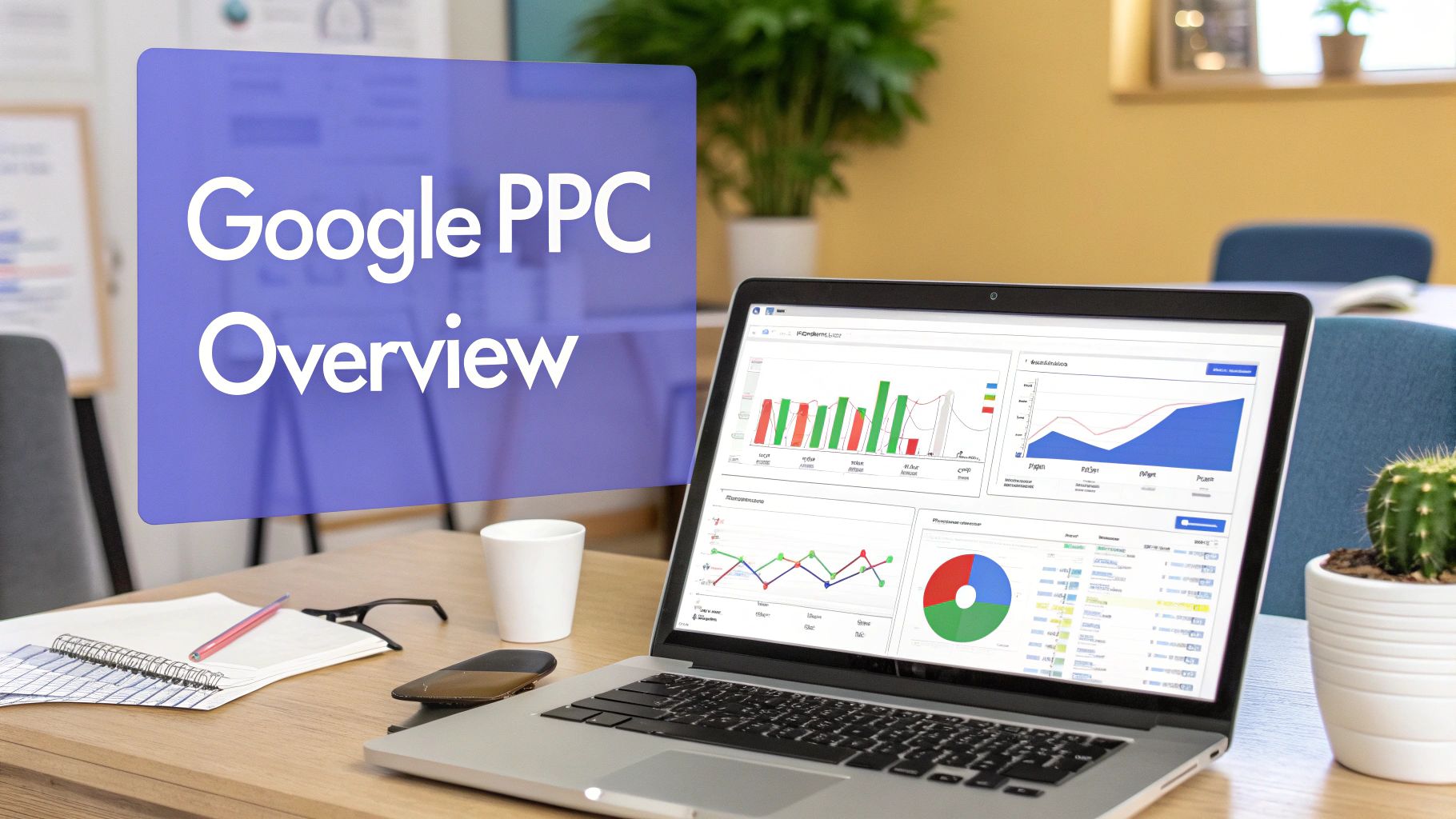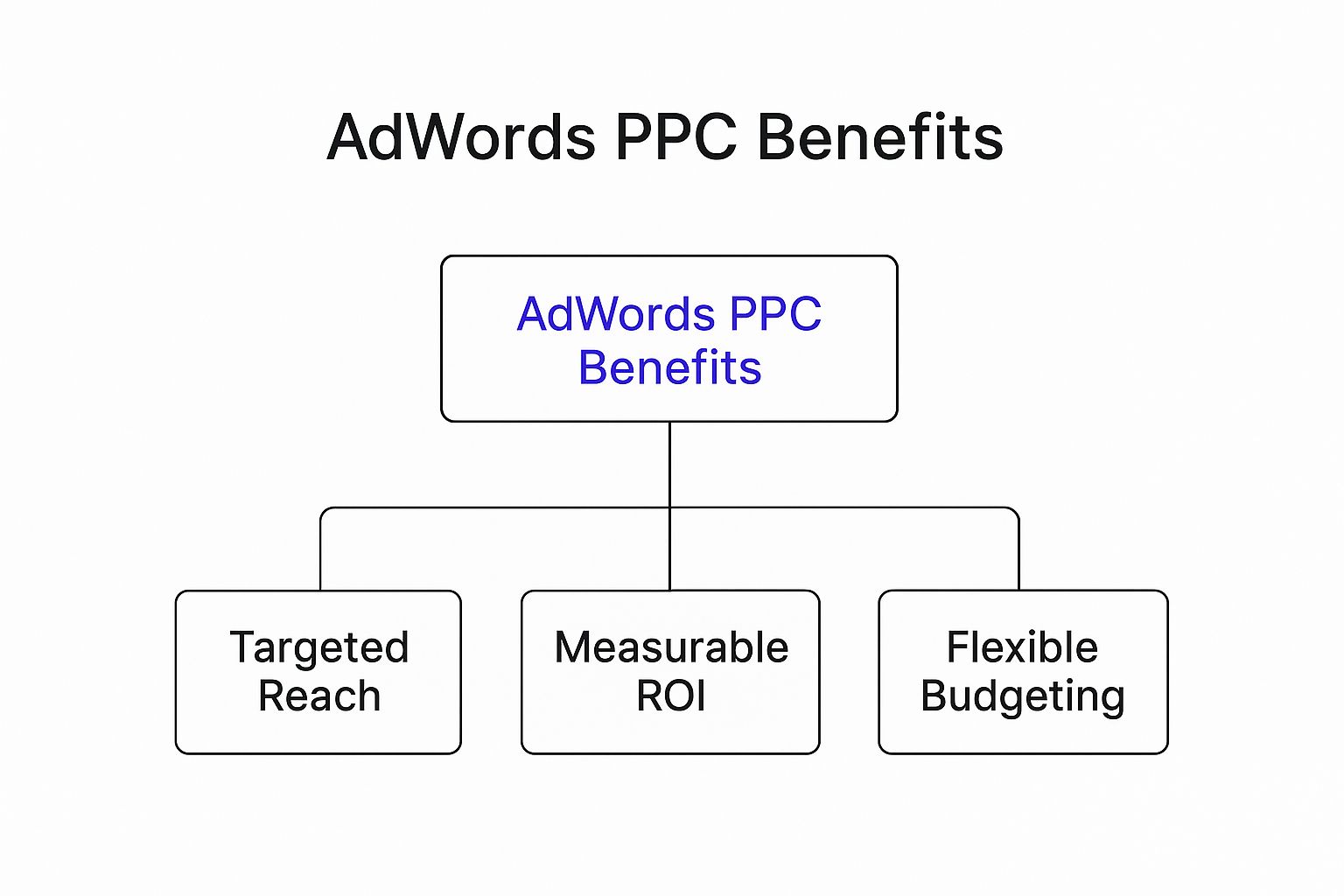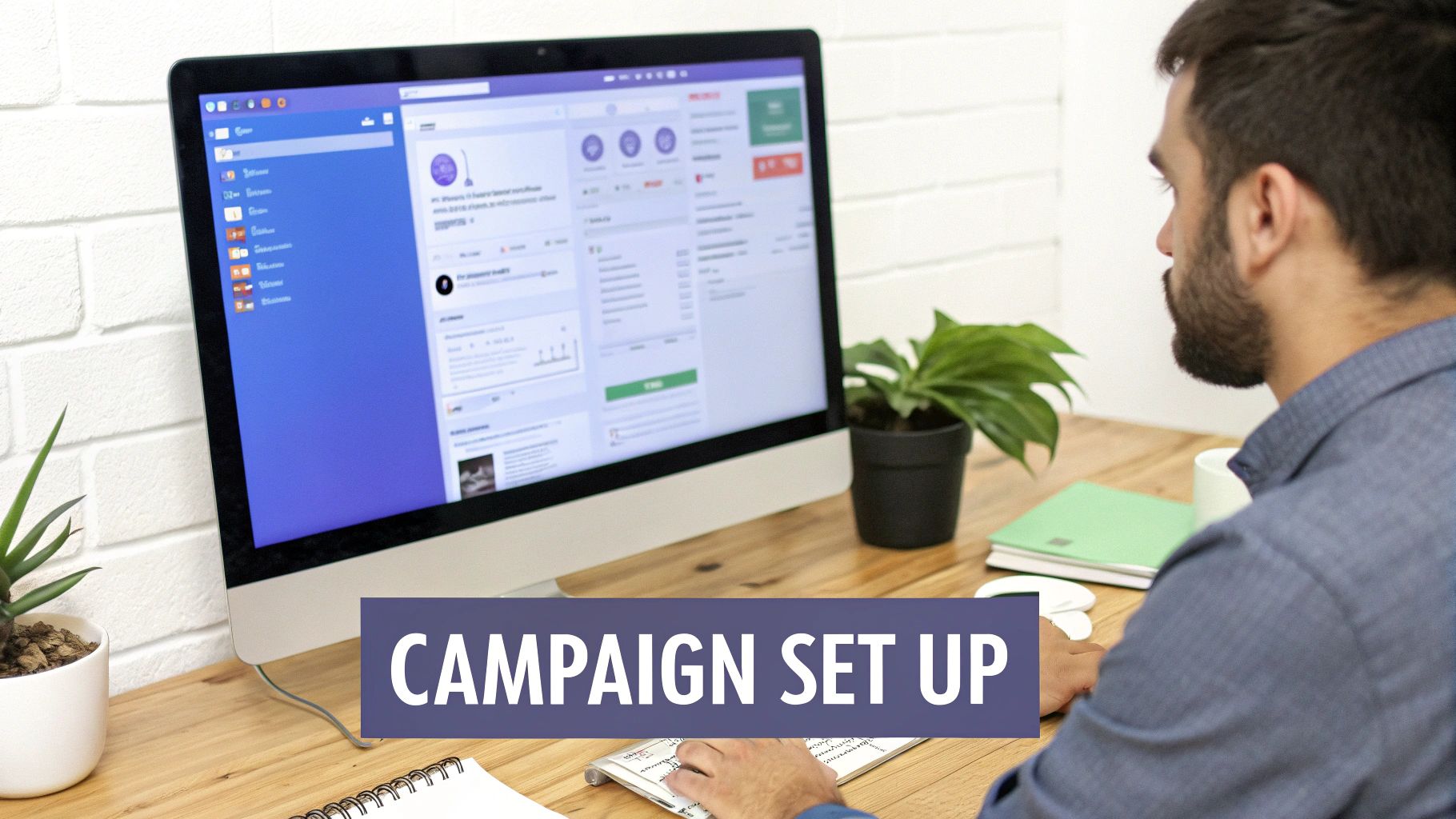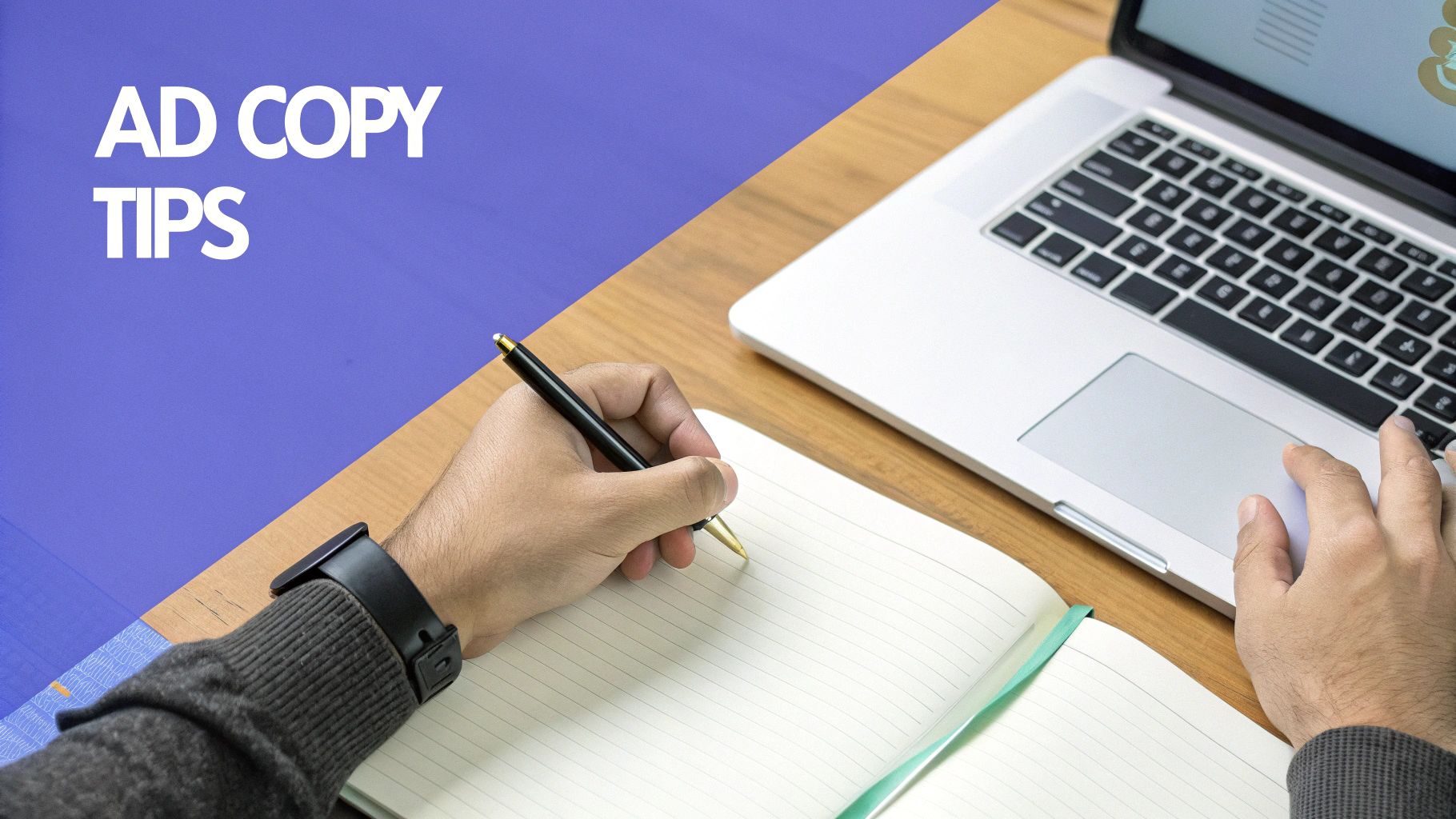Master Google AdWords PPC with our guide. Learn campaign structure, smart bidding, and optimization to drive real business growth and higher ROI.
Are you tired of waiting for organic traffic to trickle in? With Google AdWords PPC, you can put your business directly in front of customers the exact moment they’re searching for your solution. Instead of playing the long game with SEO, you pay to place your ads at the top of Google’s search results—but here’s the key: you only pay when someone actually clicks.
It’s the fastest, most direct way to buy highly targeted traffic. Sound interesting? Let's dive in.
How Google AdWords PPC Drives Business Growth
Think of Pay-Per-Click (PPC) advertising as renting a pop-up shop on the busiest digital street in the world: Google’s search results page. When a potential customer is actively looking for help, PPC lets you put your business right in their line of sight. This immediate visibility is a game-changer for driving quality traffic and generating leads when intent is highest, turning searchers into valuable leads for your sales team.
Unlike traditional advertising that casts a wide, often inefficient net, Google AdWords PPC is incredibly precise. You can target users based on the exact keywords they type, ensuring your message only reaches a motivated and relevant audience. According to HubSpot, this level of targeting is why search ads can generate a staggering 441% ROI. You’re connecting active problems with immediate solutions.
Before jumping in, it's essential to understand the language.
Core Google AdWords PPC Concepts at a Glance
This table breaks down the fundamental concepts you absolutely need to know before launching your first campaign. Consider it your quick-reference guide to the language of paid search.
| Concept | Brief Explanation |
|---|---|
| PPC (Pay-Per-Click) | An advertising model where you pay a fee each time one of your ads is clicked. |
| Keywords | The words or phrases people type into Google that trigger your ad to appear. |
| Ad Rank | The value that determines your ad's position on the search results page. |
| Quality Score | A Google metric (from 1-10) that rates the quality and relevance of your ads and keywords. |
| CTR (Click-Through Rate) | The percentage of people who click your ad after seeing it (clicks ÷ impressions). |
| CPC (Cost-Per-Click) | The actual amount you pay for each click on your ad. |
Getting these basics down is your first step toward building a campaign that doesn't just spend money, but actually generates predictable revenue.
Understanding the Digital Auction
At its heart, Google Ads runs on a massive, lightning-fast auction. Every single time someone hits "search" on Google, an auction happens in milliseconds to decide which ads appear and in what order.
But it’s not just about who’s willing to pay the most. Google combines your maximum bid with your Quality Score—a rating of your ad’s relevance and user experience—to determine your final Ad Rank. This system is designed to reward advertisers who create a great user experience, often letting you pay less for a higher ad position.

Screenshot from https://ads.google.com/home/
The main dashboard is where you'll start building out campaigns designed to reach new customers and drive growth, which is the primary focus for any B2B SaaS company investing in paid advertising.
Choosing the Right Ad Format
Your entire strategy hinges on the type of ad you decide to run. Each format plays a different role in guiding potential customers through your marketing funnel. Getting this right means you can meet your buyers where they are.
- •Search Ads: These are the text-based ads populating Google’s search results. They are perfect for capturing high-intent users who are actively searching for your exact product or service right now.
- •Display Ads: These are the visual, banner-style ads appearing across Google’s vast network of partner websites, from blogs to news sites. They work wonders for building brand awareness and retargeting people who have visited your site.
- •Video Ads: Running primarily on YouTube, these ads are unbeatable for telling a compelling story, demonstrating your product, and engaging prospects with richer, more dynamic content.
Building Your First Winning Campaign Structure
A successful Google Ads PPC campaign isn’t built on hope. It's built on a solid blueprint. Without a logical structure, you're just throwing ads at a wall and praying something sticks—a notoriously expensive strategy that rarely pays off.
Think of your Google Ads account like a well-organized library. A clear layout helps users find exactly what they need, which leads to a better experience and keeps them coming back. The same principle applies here.
A well-organized campaign directly improves your Quality Score, which is Google's rating of your ad's relevance. A higher Quality Score is a huge competitive advantage, leading to lower ad costs and better ad positions. For your B2B SaaS company, this is the holy grail: more qualified leads without blowing up your budget.
This infographic breaks down the core benefits a well-structured PPC effort delivers.

Infographic about google adwords ppc
As you can see, a great campaign isn't about just one thing. It’s the combination of precise targeting, clear ROI, and manageable budgets all working together.
The Hierarchy of a Google Ads Account
To master Google Ads, you first have to understand its structure. Your account is organized into a clear hierarchy that gives you total control over every piece of your advertising puzzle.
- •
Account: This is the mothership. It’s the top level, tied to your unique email, password, and billing info. Everything you do in Google Ads lives inside this container.
- •
Campaign: Each campaign has its own budget and settings that dictate where your ads show up. You should create separate campaigns for different product lines, locations, or strategic goals (like 'Lead Generation' vs. 'Brand Awareness').
- •
Ad Group: Inside each campaign, you have ad groups. Think of these as tightly themed containers. Each one holds a small set of very similar keywords and the specific ads written just for those keywords. For example, a SaaS company might have one ad group for "revenue operations software" and another for "sales pipeline analytics."
- •
Keywords & Ads: This is where the magic happens. Inside each ad group, you have your list of keywords that trigger your ads and the actual ad copy users see. Tightly aligning your keywords to your ad copy is absolutely critical for success.
This screenshot from Google’s own help docs illustrates the foundational relationship between these components perfectly.

Screenshot from https://support.google.com/google-ads/answer/2375422?hl=en
The visual confirms it: campaigns are the strategic buckets for your ad groups, which in turn deliver specific ads based on tightly themed keywords.
Setting Up Your B2B SaaS Campaign
Let's apply this to a real-world B2B SaaS scenario. Imagine you're marketing a revenue operations platform. Your first move is to create a new campaign with a crystal-clear, conversion-focused objective.
Key Insight: Always start by selecting 'Leads' as your campaign goal. This signals to Google’s algorithm that you want it to optimize for actions that actually fill your sales pipeline—like demo requests or whitepaper downloads—not just clicks or impressions.
For a B2B audience, the average conversion rate hovers around 3.04%, according to WordStream data. This means for every 100 clicks, you can expect about three leads.
By structuring your campaign around hyper-specific ad groups—like "HubSpot Integration" or "Salesforce Analytics"—you can create highly relevant ads that speak directly to a prospect's pain points. This is how you push that conversion rate higher. For example, one B2B client increased their trial-to-paid conversion from 12% to 18% in just 6 weeks by adopting this granular ad group strategy. This approach not only improves performance but also makes analyzing what works (and what doesn't) simpler and far more effective.
Choosing Smart Bidding and Budgeting Strategies
Your success with Google AdWords PPC isn't just about writing clever ads; it's about mastering the financial engine that fuels your campaigns. Many advertisers think winning the ad auction is just about having the deepest pockets. It's not. It’s about having the smartest bidding and budgeting strategy. This is where you tell Google how much you're willing to pay and how it should spend your money to get the best results for you.
Think of it like choosing between driving a manual or an automatic car. Both get you to your destination, but they offer totally different levels of control and efficiency. Deciding which is right for your campaign depends on your goals and, crucially, how much performance data you've already collected.

A person working on a laptop with charts and graphs in the background, representing PPC budget management
Manual vs Automated Bidding
Google Ads gives you a whole spectrum of bidding options, from fully manual to completely automated. Getting this right is the first step toward running profitable campaigns.
- •
Manual CPC (Cost-Per-Click): This is the hands-on, "stick shift" approach. You set a maximum bid for each keyword yourself, giving you total, granular control. It’s a great choice for brand new campaigns where you need to get a feel for the landscape and understand your baseline costs without letting an algorithm go wild with your budget.
- •
Automated Bidding (Smart Bidding): This is where you let Google's AI take the wheel. Using machine learning, it analyzes millions of signals in real-time—like the user's device, location, and time of day—to adjust your bids automatically. The goal is always to hit a specific outcome, like getting the most conversions possible.
Let's be clear: the future of Google Ads is automation. Google’s AI-powered Smart Bidding and automated targeting are now essential for navigating the complex PPC world. This shift lines up with what we're seeing across the industry, where paid search now commands nearly 40% of advertisers' total digital budgets. For a deeper dive, check out this market outlook from Grand View Research.
Popular Smart Bidding Strategies
Once your campaign has enough conversion data—usually 15-30 conversions over a 30-day period—it's time to let the machine do the heavy lifting. Switching to a Smart Bidding strategy can massively boost your efficiency. Here are the go-to options for your B2B SaaS:
- •Maximize Conversions: You set a daily budget, and Google's AI will work to get you the highest number of conversions it can within that budget. This is perfect for lead generation campaigns where sheer volume is the main goal.
- •Target CPA (Cost Per Acquisition): You tell Google exactly how much you're willing to pay for one conversion (like a demo request), and it automatically adjusts bids to hit that average cost. As Salesforce notes, knowing your target CPA is absolutely critical for staying profitable.
- •Maximize Conversion Value: This one is more advanced. If you assign different monetary values to your conversions (e.g., a "Request a Quote" form fill is worth more than a whitepaper download), this strategy will focus on generating the highest total value, not just the highest number of conversions.
Setting a Sensible Budget
Your budget is the safety rail that keeps your campaigns from running off a cliff. The trick is to set a daily budget you're comfortable with but that's also high enough to gather meaningful data quickly. If you want to dig deeper into the numbers, check out our detailed guide on understanding Google Ads pricing.
Actionable Tip: Use ad scheduling to focus your budget when it matters most. If your sales team only works Monday to Friday, 9 AM to 5 PM, why are you spending money on clicks at 2 AM on a Sunday? This simple tweak ensures your budget is spent when you can actually follow up and turn those expensive clicks into real leads.
Measuring Success With Key PPC Metrics
Launching a Google AdWords PPC campaign is just the starting pistol. The real race is won in the laps that follow—how you read the story your data is telling you. Pouring money into ads without tracking performance is like driving with your eyes closed. Sure, you're moving, but you have no idea if you're heading toward your destination or straight into a wall.
To make profitable decisions, you have to look past vanity numbers like clicks and impressions. You need to zero in on the performance metrics that directly impact your bottom line. These are the numbers that tell you if your investment is actually generating revenue.
The Core Four Performance Metrics
Think of these four metrics as the vital signs for your campaign's health. Monitoring them will help you diagnose problems and, more importantly, spot opportunities for growth.
- •Click-Through Rate (CTR): This is the percentage of people who actually click your ad after seeing it. A low CTR is often the first red flag that your ad copy or keyword targeting is misaligned with what searchers are looking for.
- •Conversion Rate: This measures the percentage of clicks that result in a desired action—think a demo request, a free trial signup, or a content download. For B2B SaaS, this is arguably the most important metric for gauging the effectiveness of your landing page and your overall offer.
- •Cost Per Acquisition (CPA): This tells you exactly how much you're spending to get one new customer or qualified lead. Knowing your CPA is non-negotiable for ensuring your campaigns are profitable.
- •Return On Ad Spend (ROAS): This is the ultimate measure of profitability. It calculates how much revenue you generate for every single dollar you spend on advertising. A 4:1 ROAS means you’re making $4 for every $1 spent.
To make these concepts even clearer, here’s a quick-reference table breaking down the essentials.
Essential PPC Metrics and What They Mean
| Metric | What It Measures | Why It Matters for You |
|---|---|---|
| Click-Through Rate (CTR) | (Clicks ÷ Impressions) x 100 | Indicates ad relevance and targeting accuracy. A higher CTR often leads to a better Quality Score and lower costs. |
| Conversion Rate | (Conversions ÷ Clicks) x 100 | Shows how effectively your landing page and offer are turning clicks into leads or customers. It's the ultimate test of your value proposition. |
| Cost Per Acquisition (CPA) | Total Ad Spend ÷ Total Conversions | Determines the true cost of acquiring a customer. This number must be lower than your customer's lifetime value to be profitable. |
| Return On Ad Spend (ROAS) | (Revenue from Ads ÷ Ad Spend) x 100 | The most direct measure of profitability. It answers the simple question: "Is my ad spend generating more money than it costs?" |
Keeping these numbers on your dashboard is the first step, but the real magic happens when you use them to diagnose and fix problems in your campaigns.
Diagnosing and Fixing Common Issues
When you see a metric underperforming, it’s a signal to pop the hood and see what’s wrong. For instance, a stubbornly low CTR often means your ad copy isn't compelling enough to cut through the noise and grab your audience's attention.
Example in Action: A B2B fintech client noticed their CTR was stuck at a dismal 2%. We helped them rewrite their ad copy, shifting from a generic feature list to a headline that directly addressed a key pain point: "Reduce Invoice Processing Time by 75%". The result? Their CTR shot up to 5.2%, triggering a 20% reduction in their CPA because more relevant, high-intent clicks were coming through.
Similarly, a high CPA paired with a low conversion rate often points to a problem with your landing page. The ad did its job, but the destination page failed to seal the deal. Understanding how to connect user actions to final outcomes is crucial, which is where different attribution models come into play. To see how this works in the real world, you can explore our detailed attribution model case study.
The Power of Quality Score
Beyond these core four, there's one number that has an outsized impact on your entire campaign: Quality Score. This is Google’s rating, from 1 to 10, of the overall quality and relevance of your keywords, ad copy, and landing pages.
A higher Quality Score is your most powerful lever for reducing costs. Google rewards advertisers who provide a great user experience with lower CPCs and better ad positions. Improving your score from a 5 to an 8 can cut your cost-per-click by as much as 40%.
The digital advertising scene in the UAE has seen explosive growth, with spending in the MENA region expected to grow by around 20% annually through 2024. Local e-commerce businesses have achieved incredible results by combining sharp PPC campaigns with strong SEO, leading to sales increases of 45% and ROI boosts up to 70% in just a few months. These results highlight how a deep focus on metrics can drive substantial returns. You can learn more about advertising trends in the Middle East and North Africa.
Advanced Optimization for B2B SaaS Campaigns
Got your campaigns running? Great. Now it’s time to shift from just managing your google adwords ppc campaigns to truly mastering them. Anyone can set up a campaign, but gaining a real edge in the B2B SaaS world means moving past the basics. It’s about implementing advanced tactics that filter out the noise and pull in high-value prospects.
This is how you turn a campaign that just spends money into a profitable growth engine. It starts with getting surgical with your keyword strategy. Broad keywords cast a wide net, sure, but they also attract a ton of unqualified traffic that will bleed your budget dry.

A person at a desk analyzing complex data on multiple computer screens, signifying advanced PPC optimization.
Sophisticated Keyword and Ad Copy Tactics
First things first: you need to become relentless with negative keywords. These are the terms you explicitly tell Google not to show your ads for. For a B2B SaaS company, this isn’t just a good idea; it’s non-negotiable.
Actionable Tip: Build a robust negative keyword list that immediately excludes job seekers, students, and people looking for freebies. Start with terms like "free," "jobs," "career," "salary," "template," and "course." This one move will instantly improve the quality of every click you pay for.
At the same time, you should be digging for long-tail keywords. These are longer, more specific phrases—think "revenue operations software for HubSpot users" instead of just "revops software." They have lower search volume, but the intent behind them is sky-high. The traffic they bring in is significantly more qualified and converts at a much better rate.
Your ad copy has to match this level of precision. Ditch the generic feature lists. Your headlines need to speak directly to the pain points and desired outcomes of your ideal customer. Focus on the ROI and the specific problem your platform solves.
Optimizing the Post-Click Experience
Getting the click is only half the battle. A fantastic ad that leads to a terrible landing page is a waste of money. Your landing page must be a seamless extension of your ad, delivering exactly what you promised.
For your B2B SaaS, this means designing a frictionless experience that respects your prospect's time. The page should be laser-focused on a single goal, whether that’s booking a demo or downloading a guide. For a deeper look at how this fits into your overall toolset, check out our guide on building the right revenue operations tech stack for B2B SaaS.
Run your landing pages through this quick checklist:
- •Compelling Headline: Does it mirror your ad copy and nail the value proposition?
- •Targeted Messaging: Is the content speaking directly to your audience’s biggest challenges?
- •Social Proof: Are you showing off client logos, testimonials, or powerful case study stats?
- •Frictionless Form: Is your form short? Are you only asking for what you absolutely need?
- •Clear Call-to-Action (CTA): Is the button impossible to miss? Is the action clear (e.g., "Get Your Free Demo")?
In competitive digital ad markets like the UAE, every single click counts. The average cost-per-click (CPC) there was around 1.75 U.S. dollars as of May 2023. As you can discover more about these regional advertising statistics on Statista, this high cost highlights just how critical it is to get your targeting and creative right. By optimizing both your ads and your landing pages, you ensure every dollar you spend is on clicks that actually have a chance to convert.
Got Questions About Google Ads? We've Got Answers.
When you're the one holding the budget, diving into google adwords ppc naturally brings up some tough questions. We hear them all the time from B2B SaaS and Fintech leaders. This section cuts straight to the chase.
No fluff, just direct answers to help you manage your campaigns with more confidence and make smarter decisions. Let's get into what’s likely on your mind.
How Much Should I Spend on Google Ads?
There's no magic number here. Your right budget isn't a random figure; it's a strategic decision tied directly to your market's competitiveness and what you're trying to achieve.
Instead of guessing, work backward. Start by defining your target Cost Per Acquisition (CPA). For example, if you know a qualified lead is worth AED 200 to your business and your ads are converting 5% of clicks into leads, you can afford to pay up to AED 10 per click.
A good starting point is a modest daily budget you're comfortable with—maybe AED 50-100—just to gather that initial performance data. From there, you scale what’s working, always keeping your eye on Return On Ad Spend (ROAS), not just the raw spend.
How Long Until I See Results from Google Ads?
Traffic and clicks? You'll see those almost immediately after your campaign goes live. But the results that actually move the needle—like demo requests and qualified leads—typically take one to three months of consistent effort to start rolling in.
Think of this initial period as a critical learning phase. For the first 90 days, you and Google's AI are figuring out which keywords, ad copy, and bidding strategies are actually delivering. While clicks are instant, profitable outcomes are the result of patient, data-driven optimization.
What Is the Difference Between Google Ads and SEO?
Both are about capturing traffic from Google, but they’re two sides of the same coin, playing fundamentally different roles in your growth strategy.
- •Google Ads (PPC): This is paid advertising. You pay for clicks to appear at the top of the search results, often within hours. It gives you immediate visibility and a high degree of control over your messaging and targeting.
- •SEO (Search Engine Optimization): This is the long game. You're optimizing your website's content and technical foundation to earn a high ranking organically. It’s "free" in terms of ad spend but requires a significant investment in time, content, and expertise.
A truly effective strategy doesn’t choose one over the other; it uses both. You can use PPC to deliver immediate, targeted results while your SEO builds sustainable, long-term authority and a reliable stream of organic traffic. They work better together.
Is your B2B SaaS go-to-market engine feeling disconnected? Altior & Co. helps scaling companies fix pipeline gaps and align sales and marketing with a data-driven RevOps Growth Blueprint. Discover how we can help you build a predictable growth engine.
Altior Team
RevOps Specialists
Helping B2B SaaS companies build predictable revenue engines through strategic RevOps implementation.

